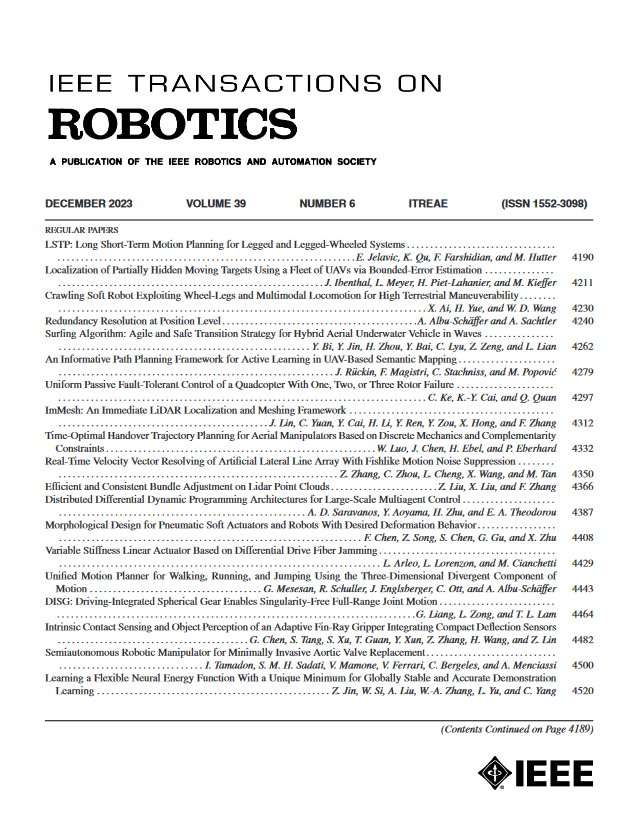Terradynamics of Monolithic Soft Robot Driven by Vibration Mechanism
IF 10.5
1区 计算机科学
Q1 ROBOTICS
引用次数: 0
Abstract
In this article, we present a design concept, in which a monolithic soft body is incorporated with a vibration-driven mechanism, called基于振动机构驱动的整体式软机器人地面动力学研究
在这篇文章中,我们提出了一个设计概念,其中一个单片软体与一个振动驱动机构,称为Leafbot。我们首先报道了机器人肢体的形态设计,这有利于我们的振动驱动模型的向前运动,并增强了应对倾斜障碍物和不规则地形的能力。其次,研究了实现这种软单片结构的制造技术和肢体形态。第三,我们通过分析和经验方法阐明了在平坦和均匀表面条件下Leafbot在高频激励下的运动。在这种情况下达到的最大速度是5个身长/秒。最后,构建了三个模型设计,每个模型都具有不同的肢体模式。我们研究了三种模式在三种预设条件下的地形动力学特征,即克服斜坡的成功率、半圆形障碍物和由崎岖因素专门化的台阶地形。本研究旨在为振动驱动软机器人在更复杂和受限环境下的进一步大地动力学研究奠定基础,并在检测任务中具有潜在的应用前景。
本文章由计算机程序翻译,如有差异,请以英文原文为准。
求助全文
约1分钟内获得全文
求助全文
来源期刊

IEEE Transactions on Robotics
工程技术-机器人学
CiteScore
14.90
自引率
5.10%
发文量
259
审稿时长
6.0 months
期刊介绍:
The IEEE Transactions on Robotics (T-RO) is dedicated to publishing fundamental papers covering all facets of robotics, drawing on interdisciplinary approaches from computer science, control systems, electrical engineering, mathematics, mechanical engineering, and beyond. From industrial applications to service and personal assistants, surgical operations to space, underwater, and remote exploration, robots and intelligent machines play pivotal roles across various domains, including entertainment, safety, search and rescue, military applications, agriculture, and intelligent vehicles.
Special emphasis is placed on intelligent machines and systems designed for unstructured environments, where a significant portion of the environment remains unknown and beyond direct sensing or control.
 求助内容:
求助内容: 应助结果提醒方式:
应助结果提醒方式:


